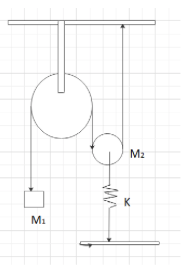
What would be the period of the free oscillations of the system shown here if mass

A)
B)
C)
D)

Answer
487.5k+ views
Hint:In this question, we can calculate the force equations for both masses. After that we can use both equations and deduce them in one equation. We have to simplify the equation to form the equation of SHM. After comparing this equation with the standard equation, we can find the expression for frequency.
Complete step by step solution: -
Let the system spring extended by
So, we have force equation as for the both masses-
For
And for
Now consider displacement of mass
So, for
For
Multiplying equation (iii) by
Putting the value of
Comparing this equation with
Angular frequency,
We know that the time period,
Putting the value of
Therefore, option C is correct.
Note: -In this question, we have to remember that the force equations for both masses are different for the first mass there is no spring so the equation does not have a spring constant. While for the second mass the spring is attached so the spring constant part will be in the equation. We have to try to deduce the equation in such a way that the final equation will be in the form of
Complete step by step solution: -
Let the system spring extended by
So, we have force equation as for the both masses-
For
And for
Now consider displacement of mass
So, for
For
Multiplying equation (iii) by
Putting the value of
Comparing this equation with
Angular frequency,
We know that the time period,
Putting the value of
Therefore, option C is correct.
Note: -In this question, we have to remember that the force equations for both masses are different for the first mass there is no spring so the equation does not have a spring constant. While for the second mass the spring is attached so the spring constant part will be in the equation. We have to try to deduce the equation in such a way that the final equation will be in the form of
Latest Vedantu courses for you
Grade 11 Science PCM | CBSE | SCHOOL | English
CBSE (2025-26)
School Full course for CBSE students
₹41,848 per year
Recently Updated Pages
Master Class 11 Economics: Engaging Questions & Answers for Success

Master Class 11 Business Studies: Engaging Questions & Answers for Success

Master Class 11 Accountancy: Engaging Questions & Answers for Success

Master Class 11 English: Engaging Questions & Answers for Success

Master Class 11 Computer Science: Engaging Questions & Answers for Success

Master Class 11 Maths: Engaging Questions & Answers for Success

Trending doubts
State and prove Bernoullis theorem class 11 physics CBSE

What are Quantum numbers Explain the quantum number class 11 chemistry CBSE

Write the differences between monocot plants and dicot class 11 biology CBSE

Who built the Grand Trunk Road AChandragupta Maurya class 11 social science CBSE

1 ton equals to A 100 kg B 1000 kg C 10 kg D 10000 class 11 physics CBSE

State the laws of reflection of light




